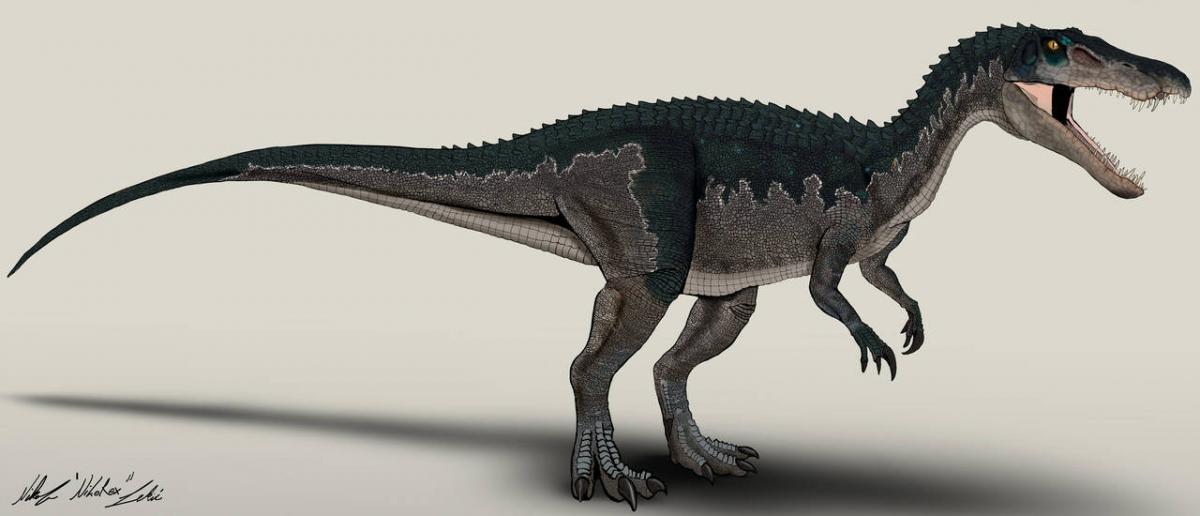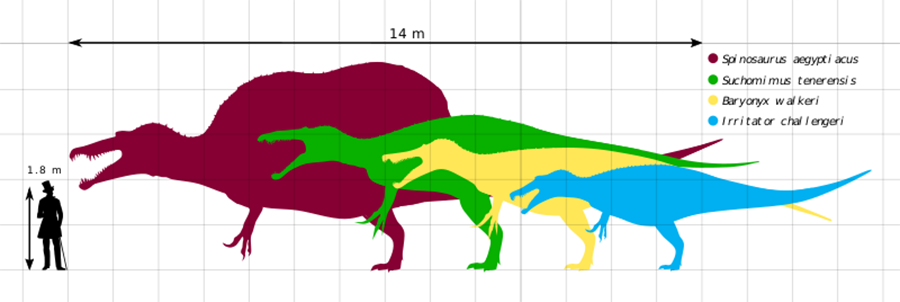How Did Baryonyx Change What We Knew About Spinosaurs?
In 1983, fossil hunter William Walker uncovered a giant claw in a brick pit in Surrey. A team of palaeontologists from the Museum began to investigate the site and had soon dug up one of the most complete meat-eating dinosaurs ever found in the UK.
But the creature they had found was in many ways very different to previously known theropods.
Spinosaurus was named by the palaeontologist Ernst Stromer in 1915 and was the world's first-named spinosaur, a dinosaur in the family Spinosauridae. Today it is widely known thanks in part to a starring role in Jurassic Park III.
For a long time, relatively little was known about the ancient creature. The initial Spinosaurus fossils were destroyed by bombing during the Second World War, leaving palaeontologists with few fossil fragments to study.
But with the discovery of Baryonyx in 1983, palaeontologists were suddenly in possession of vital clues to how this family of giant reptiles might have lived.
How was Baryonyx discovered?
Baryonyx was first discovered by fossil collector William J Walker in January 1983 as he explored a clay pit near Ockley, Surrey.
Dr Susie Maidment, a dinosaur researcher at the Museum, says, 'He found a little bit of the claw sticking out of the rock. So he dug it out and brought it to the Museum.'
William J Walker was the first to find evidence of the spinosaur Baryonyx. He discovered a giant fossilised claw in a brick pit in Surrey.
The fossilised claw was enormous, its outer curved side measuring 31 centimetres. A team from the Museum travelled to Surrey to investigate further. Between May and June 1983, palaeontologists excavated a reasonably complete animal that they determined to be a new species of dinosaur.
They named the new dinosaur Baryonyx walkeri - 'Baryonyx' meaning 'heavy claw' and 'walkeri' in tribute to its finder.
The fossilised claw bone discovered in Surrey was approximately 31 centimetres along its outer curved edge. In life, the claw would have been covered in a layer of keratin, making it even larger.
In what way was Baryonyx unique?
From the initial investigation of the skeleton it was determined that although Baryonyx was clearly a meat-eating theropod, in a number of ways it didn't resemble any that had been discovered before, such as Tyrannosaurus or Megalosaurus.
'When they started working on Baryonyx they noticed that the nostrils were set very far back. Also, if you turn the snout over and look inside the mouth, you can see that it's got a sort of rosette shape. That is really characteristic of animals that eat fish,' explains Susie.
'It also had teeth that were quite crocodilian. They are quite rounded in cross section rather than flat like we see in lots of other meat-eating dinosaurs.'
A rosette-shaped snout, seen here in the Baryonyx collected in 1983, is a feature seen in modern crocodiles and some ancient marine-dwelling reptiles. It suggests that Baryonyx and other spinosaurs may have had a fish-based diet.
Although controversial, some research has suggested that Spinosaurus, which was a relation of Baryonyx, may have been a predominantly aquatic dinosaur. But scientists currently think that Baryonyx spent most of its time on land.
'The interpretation of this enormous claw on the hand is that they used it a bit like a bear. They think Baryonyx might have stood on the banks of rivers and hooked fish out using it,' says Susie.
'Baryonyx may have swum about a bit, especially with those set back nostrils, but I don't think it lived its life in the water - it mostly would have splashed about on the banks.'
But although it was adapted to hunt fish, it appears that the Surrey Baryonyx had a more varied last meal.
Susie explains, 'They found what they thought could be its stomach contents in its abdominal region. There were fish scales and also Iguanodon bones, so these dinosaurs probably weren't only eating fish but would have eaten whatever was going.'
What was the UK like when Baryonyx lived?
Baryonyx was found in the Wealden Group, in rocks which are around 125 million years old. This dinosaur's adaptations to life on the water's edge were likely well suited to its waterlogged habitat in southeast England.
Baryonyx's nostrils were set quite far back on its snout, compared to other meat-eating dinosaurs like Tyrannosaurus. This was one of the first features palaeontologists noticed when they began working on the dinosaur.
When this dinosaur lived, the south of England down to the northern coast of France was mostly a large expanse of swampy lagoons and meandering rivers.
'There were other dinosaurs in the area at the time, like Iguanodon, Mantellisaurus and ankylosaurs like Polacanthus. There were also some big sauropods around and crocodiles,' explains Susie.
'Grasses hadn't evolved yet, so plants would have been things like horsetails, club mosses and ferns. Baryonyx was living in an environment that would have been quite swampy.'
Mantellisaurus was one of the dinosaurs that lived in the same area as Baryonyx. You can see this skeleton of Mantellisaurus in Hintze Hall at the Museum.
What is related to Baryonyx?
The Baryonyx skeleton found in Surrey in 1983 is the most complete example of its species.
Susie says, 'It's known from pretty much a complete skull, including its snout and its brain case, and from lots of the postcrania as well. But when they found it they really didn't know much about these types of dinosaurs at all.'
Some of the fossils of the Baryonyx skeleton collected near Ockley in Surrey in 1983 from the Museum collection.
Baryonyx is a spinosaur. The first spinosaur to be found was Spinosaurus, which was discovered in Egypt in 1912 and named in 1915. Spinosaurus is believed to have been one of the largest meat-eaters ever to have lived. But this important type specimen was destroyed by bombing in Munich in 1944.
However, the discovery of Baryonyx almost 50 years later gave new insights into spinosaurs. Today, many reconstructions of Spinosaurus are partly based on what has been learnt from its cousin Baryonyx.
So far, Baryonyx fossil discoveries have been made in the UK and Spain, although related spinosaurs have been found around the world. Spinosaurus specimens have been discovered in Morocco and Egypt, Suchomimus in Niger and Irritator in Brazil.
Spinosaurus is considered to be the world's first spinosaur, however spinosaurids had been found prior to this. Two teeth discovered in England in 1820 were originally thought to be crocodilian, but they were reassigned to the spinosaur Suchosaurus in 1998.
Susie says, 'We haven't really got any other dinosaurs that have a large amount of their diet made up of fish. We don't really see that similar long snout and set back nostrils in other theropods - that's just one of the things that makes dinosaurs like Bayronyx and Spinosaurus exciting and different.'
Source: www.nhm.ac.uk











